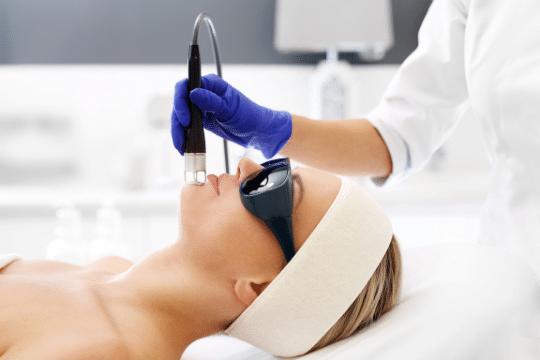
What is laser skin resurfacing?
A dermatologist or surgeon performs laser skin resurfacing, which is a type of skincare treatment. It entails the use of lasers to help enhance the texture and appearance of the skin.
Your dermatologist can prescribe either ablative or non-ablative lasers, depending on your specific needs. Carbon dioxide (CO2) and Erbium are examples of ablative lasers. Scars, warts, and deep wrinkles can all be removed with CO2 laser resurfacing treatments. Erbium is a metal used to treat fine lines and wrinkles, and other superficial skin issues. Both forms of ablative lasers strip the skin’s outer layers.
Non-ablative lasers, on the other hand, do not strip any layers of the skin. Pulsed light, pulsed dye lasers, and fractional lasers are examples of these. Rosacea, spider veins, and acne-related skin conditions can all be treated with non-ablative lasers.
Please continue reading to learn more about the procedure, like how it works, why it’s performed, and potential side effects.
What to expect during the operation
Laser skin resurfacing heats the lower layers of the dermis when targeting the outer layer of the skin. Collagen production will be boosted as a result of this.
New collagen fibers can, in theory, aid in the production of new skin that is smoother in texture and firmer to the touch.
The measures in the procedure are as follows:
- The skin must be prepared before laser skin resurfacing. A series of methods must be completed several weeks before the operation. The aim is to make your skin more resistant to professional treatments. It can also reduce the chances of experiencing adverse side effects.
- The doctor will apply a topical anesthetic to the region to be handled on the day of the operation. This is used to make you feel relaxed during the procedure by reducing discomfort. If you have a wide area of skin to treat, your doctor can recommend a sedative or pain reliever.
- After that, the skin is cleansed to eliminate any extra oil, dirt, or bacteria.
- Your doctor will begin the treatment with the laser of your choice. The laser is slowly pushed across the skin’s defined region.
- Finally, after the operation, your doctor will cover the treatment area in wraps to protect the skin.
How far does it set you back?
Medical insurance does not cover laser skin resurfacing because it is considered a cosmetic operation.
The price of a laser varies depending on the type of laser used. Non-ablative laser treatments cost around $1,031 per session, while ablative laser treatments cost about $2,330 per session.
The total cost is also determined by the number of sessions required and the region to be handled. Some dermatologists with more experience can charge more per session. You’ll probably need several laser resurfacing sessions to get the results you want.
What do we expect from the outcomes?
Non-ablative laser treatments are less likely to cause side effects, but you can need several treatments to get the results you want. On the other hand, ablative lasers can be able to resolve the issues in only one session.
Individual outcomes differ depending on the severity of the initial problems addressed. If you’ve completed your therapy sessions, you should expect your results to last for many years. The effects, however, aren’t lasting. At some point, you will need to repeat the process.



